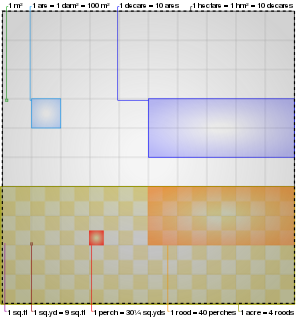| Revision as of 04:12, 4 October 2022 editClueBot NG (talk | contribs)Bots, Pending changes reviewers, Rollbackers6,439,386 editsm Reverting possible vandalism by 2409:4053:2D8A:AE00:0:0:C1CB:D80B to version by Ava Eva Thornton. Report False Positive? Thanks, ClueBot NG. (4178985) (Bot)Tag: Rollback← Previous edit | Revision as of 18:03, 1 December 2022 edit undoCoaceyy (talk | contribs)2 editsm An example of visualizing square meter area.Tag: Visual editNext edit → | ||
| Line 10: | Line 10: | ||
| }} | }} | ||
| {{Comparison_area_units.svg}} | {{Comparison_area_units.svg}} | ||
| ⚫ | The '''square metre''' (] as used by the ]) or '''square meter''' (]) is the unit of ] in the ] (SI) with symbol '''m<sup>2</sup>'''.<ref>{{citation | editor=David R. Lide | chapter=INTERNATIONAL SYSTEM OF UNITS | title=] | edition=90th | year=2010}}</ref> It is the area of a ] with sides one ] in length. | ||
| ⚫ | === The '''square metre''' (] as used by the ]) or '''square meter''' (]) is the unit of ] in the ] (SI) with symbol '''m<sup>2</sup>'''.<ref>{{citation | editor=David R. Lide | chapter=INTERNATIONAL SYSTEM OF UNITS | title=] | edition=90th | year=2010}}</ref> It is the area of a ] with sides one ] in length. === | ||
| Adding and subtracting ]es creates multiples and submultiples; however, as the unit is ]d, the ] ] by the corresponding ]. For example, 1 ] is 10<sup>3</sup> (one ]) times the length of 1 metre, but 1 square kilometre is (10<sup>3</sup>)<sup>2</sup> (10<sup>6</sup>, one ]) times the area of 1 square metre, and 1 cubic kilometre is (10<sup>3</sup>)<sup>3</sup> (10<sup>9</sup>, one ]) cubic metres. | Adding and subtracting ]es creates multiples and submultiples; however, as the unit is ]d, the ] ] by the corresponding ]. For example, 1 ] is 10<sup>3</sup> (one ]) times the length of 1 metre, but 1 square kilometre is (10<sup>3</sup>)<sup>2</sup> (10<sup>6</sup>, one ]) times the area of 1 square metre, and 1 cubic kilometre is (10<sup>3</sup>)<sup>3</sup> (10<sup>9</sup>, one ]) cubic metres. | ||
| Line 92: | Line 92: | ||
| * {{val|1550.0031}} ]es | * {{val|1550.0031}} ]es | ||
| {{Div col end}} | {{Div col end}} | ||
| == Examples == | |||
| * One square metre can stand up to 5 people at the same time.<ref>{{Cite web |title=Standing Crowd Density {{!}} Prof. Dr. G. Keith Still |url=https://www.gkstill.com/Support/crowd-density/CrowdDensity-1.html |access-date=2022-12-01 |website=www.gkstill.com}}</ref> | |||
| ==See also== | ==See also== | ||
Revision as of 18:03, 1 December 2022
SI-derived unit of area "m^2" redirects here. For other uses, see m² (disambiguation).| Square metre | |
|---|---|
| Unit system | SI |
| Unit of | area |
| Symbol | m |

The square metre (international spelling as used by the International Bureau of Weights and Measures) or square meter (American spelling) is the unit of area in the International System of Units (SI) with symbol m. It is the area of a square with sides one metre in length.
Adding and subtracting SI prefixes creates multiples and submultiples; however, as the unit is exponentiated, the quantities grow exponentially by the corresponding power of 10. For example, 1 kilometre is 10 (one thousand) times the length of 1 metre, but 1 square kilometre is (10) (10, one million) times the area of 1 square metre, and 1 cubic kilometre is (10) (10, one billion) cubic metres.
SI prefixes applied

The square metre may be used with all SI prefixes used with the metre.
| Multiplication | Name | Symbol | Multiplication | Name | Symbol |
|---|---|---|---|---|---|
| 10 | square metre (centiare) | m | 10 | square metre (centiare) | m |
| 10 | square decametre (are) | dam | 10 | square decimetre | dm |
| 10 | square hectometre (hectare) | hm | 10 | square centimetre | cm |
| 10 | square kilometre | km | 10 | square millimetre | mm |
| 10 | square megametre | Mm | 10 | square micrometre | μm |
| 10 | square gigametre | Gm | 10 | square nanometre | nm |
| 10 | square terametre | Tm | 10 | square picometre | pm |
| 10 | square petametre | Pm | 10 | square femtometre | fm |
| 10 | square exametre | Em | 10 | square attometre | am |
| 10 | square zettametre | Zm | 10 | square zeptometre | zm |
| 10 | square yottametre | Ym | 10 | square yoctometre | ym |
Unicode characters
Unicode has several characters used to represent metric area units, but these are for compatibility with East Asian character encodings and are not meant to be used in new documents.
- U+33A1 ㎡ SQUARE M SQUARED
- U+33A2 ㎢ SQUARE KM SQUARED
- U+3378 ㍸ SQUARE DM SQUARED
- U+33A0 ㎠ SQUARE CM SQUARED
- U+339F ㎟ SQUARE MM SQUARED
Instead, the Unicode superscript U+00B2 ² SUPERSCRIPT TWO can be used, as in m².
Conversions
One square metre is equal to:
- 0.000001 square kilometre (km)
- 10000 square centimetres (cm)
- 0.0001 hectares (ha)
- 0.001 decares (daa)
- 0.01 ares (a)
- 0.1 deciares (da)
- 1 centiare (ca)
- 0.000247105381 acres
- 0.0247105381 cents
- 1.195990 square yards
- 10.763911 square feet
- 1550.0031 square inches
Examples
- One square metre can stand up to 5 people at the same time.
See also
Notes
- David R. Lide, ed. (2010), "INTERNATIONAL SYSTEM OF UNITS", CRC Handbook of Chemistry and Physics (90th ed.)
- Unicode Consortium (2019). "The Unicode Standard 12.0 – CJK Compatibility ❰ Range: 3300—33FF ❱" (PDF). Unicode.org. Retrieved May 24, 2019.
- "Standing Crowd Density | Prof. Dr. G. Keith Still". www.gkstill.com. Retrieved 2022-12-01.
External links
- BIPM (SI maintenance agency) (home page)
- BIPM brochure (SI reference)